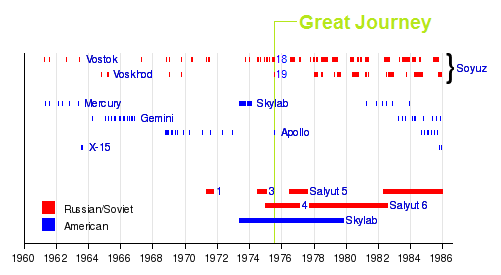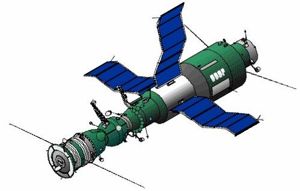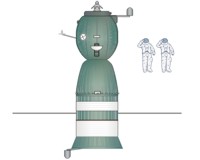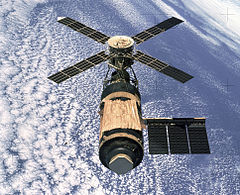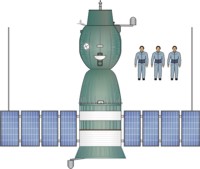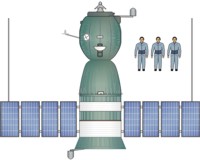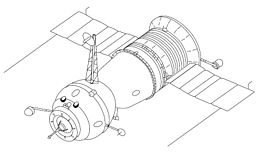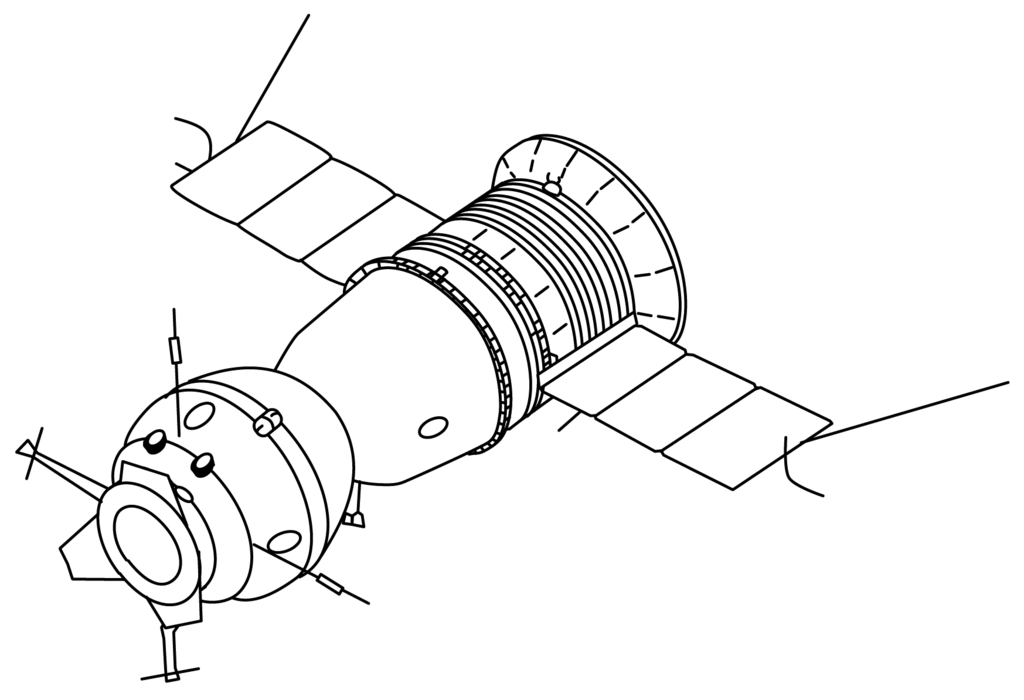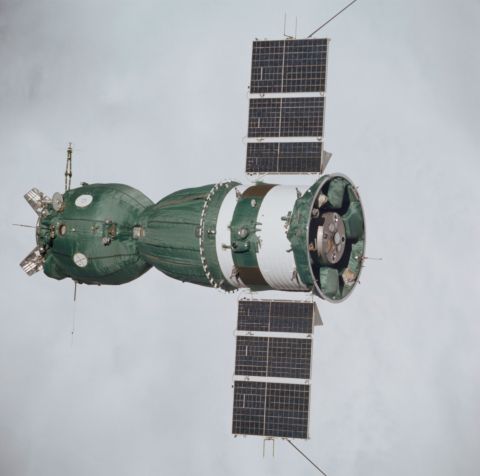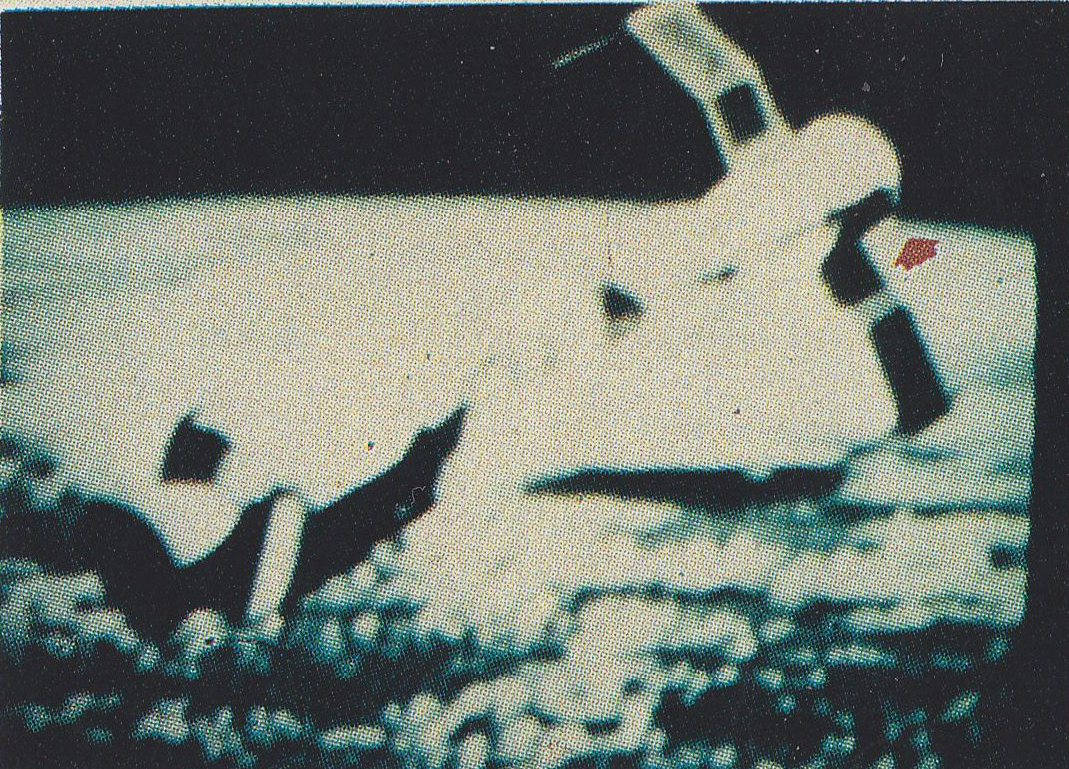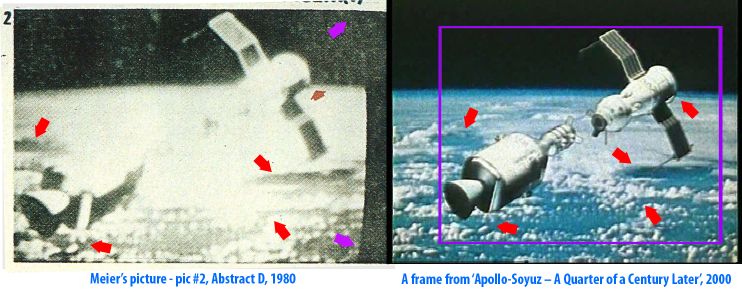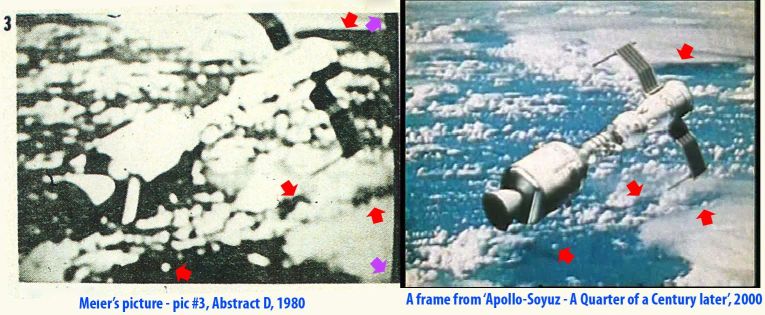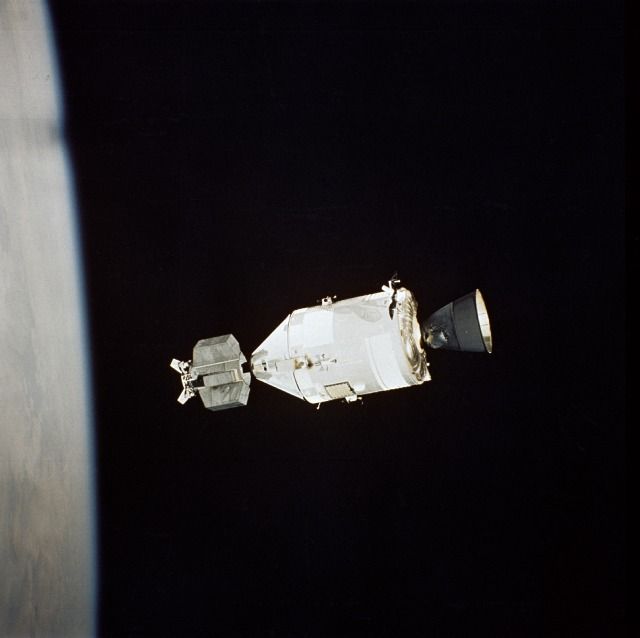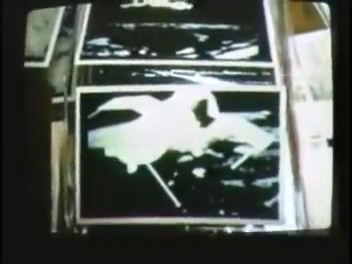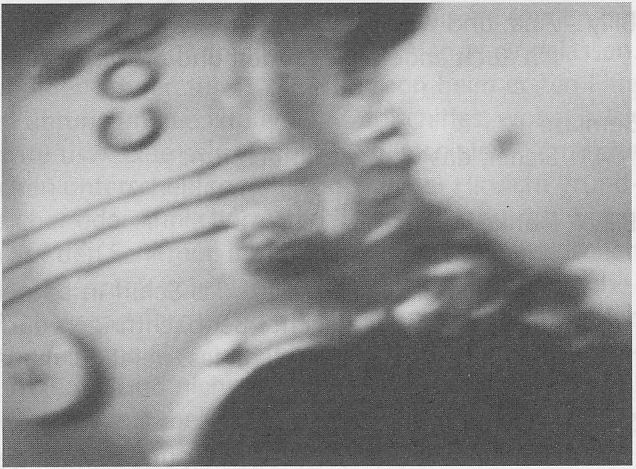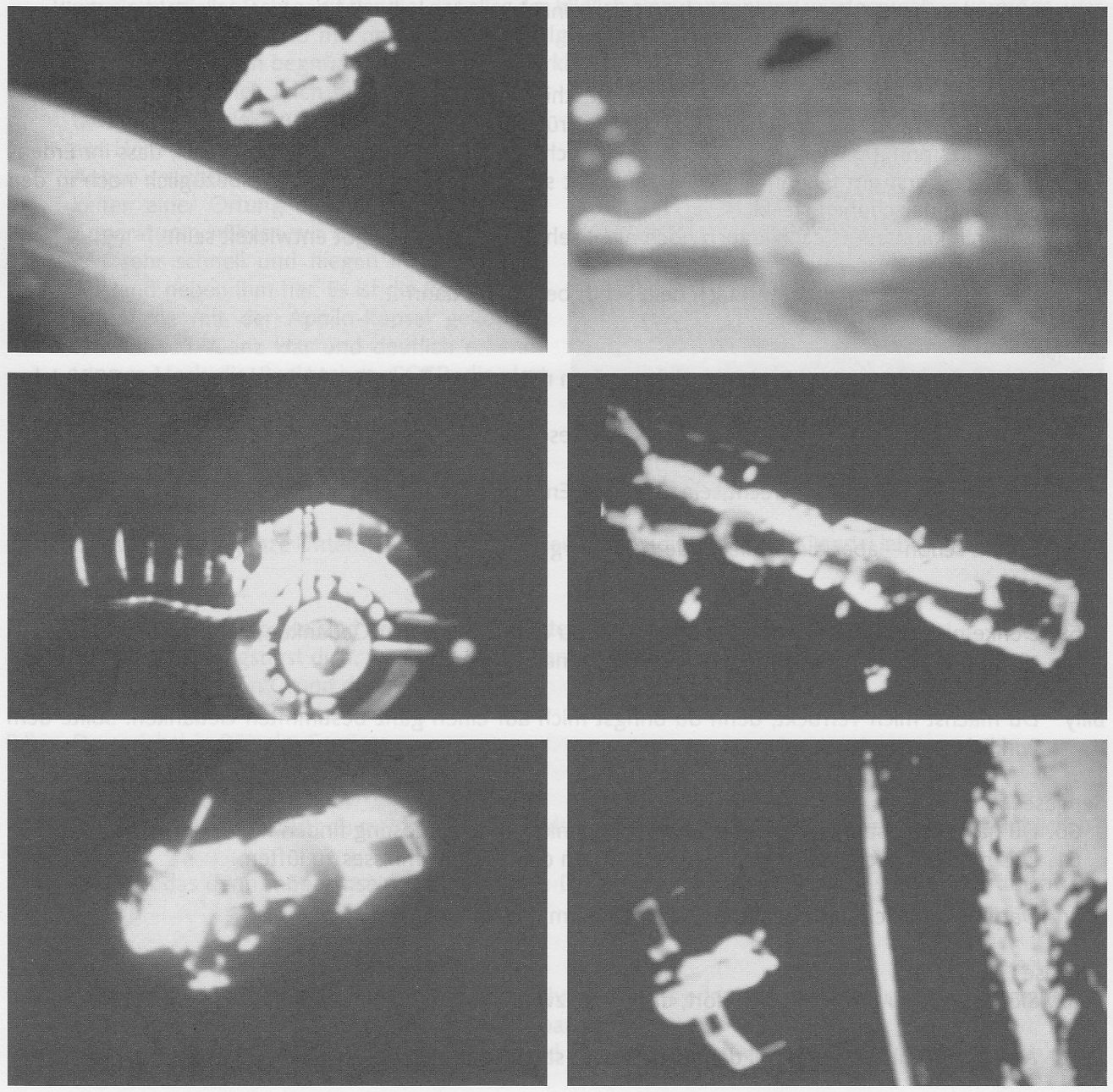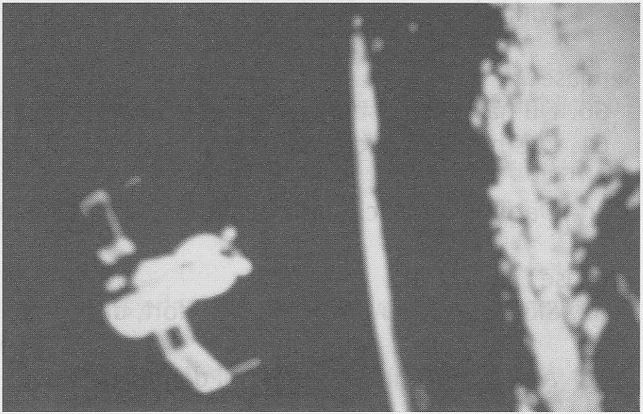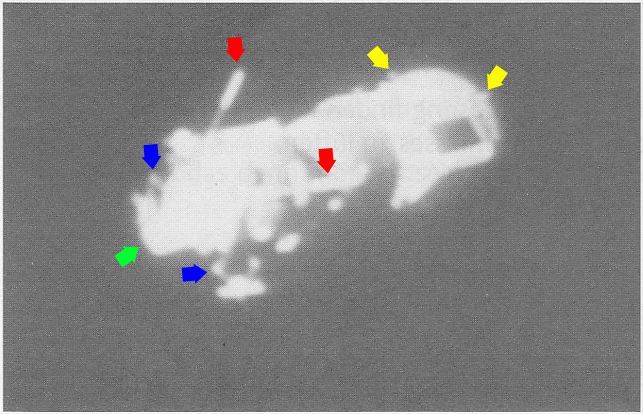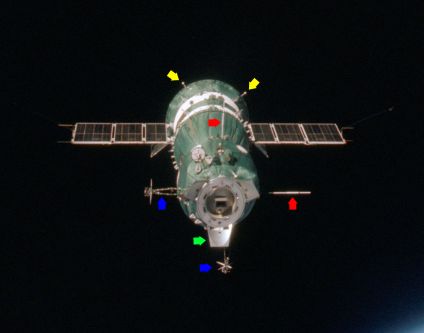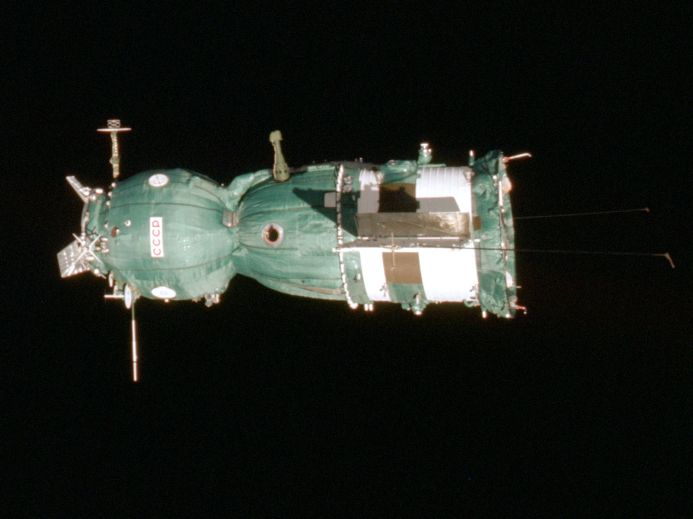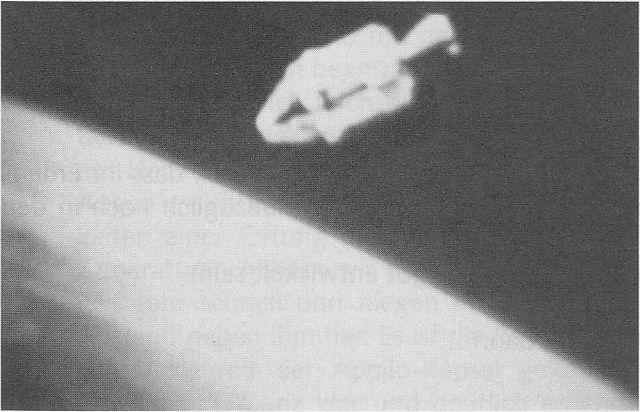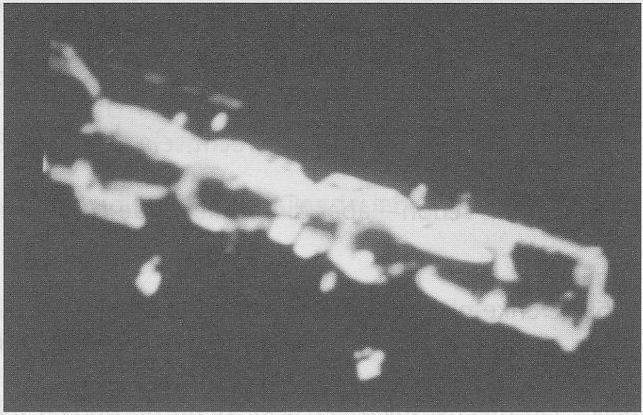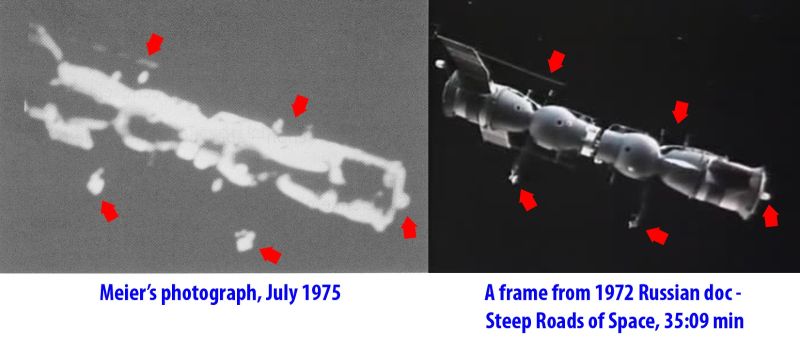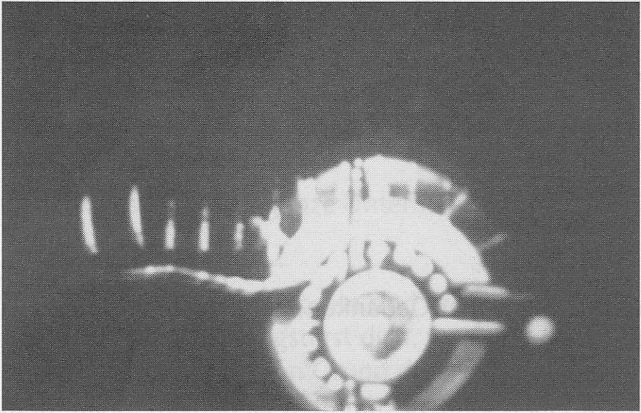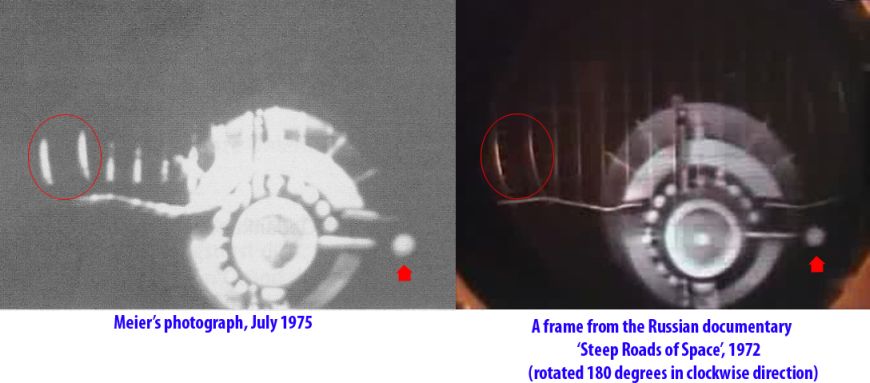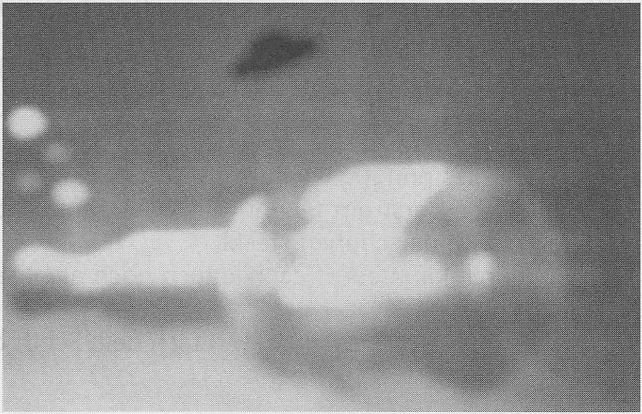Note: For a short summary of the following in-depth investigation and analysis, visit this page.
Contents
INTRODUCTION
During Meier’s Great Journey in space described in Contact Report 31, which took place from July 17-22, 1975, he allegedly witnessed the coupling between the USA Apollo spacecraft and the USSR Soyuz spacecraft on July 17. This was a joint venture of the USA and USSR called the Apollo Soyuz Test Project (ASTP). The primary purpose of this project was to be a symbol of the policy of détente that the two superpowers were pursuing at the time, and it marked the end of the Space Race between them that began in 1957.
During the Great Journey, Meier was also allowed to take pictures of the Apollo-Soyuz coupling and also of various stars and planets. Soon after Meier’s journey it was discovered that many of the pictures were manipulated or replaced with forgeries. This allegedly prompted the Plejaren ET Quetzal to take away and destroy most of Meier’s forged pictures, but a few dozen of the outer space pictures were left with FIGU Core Group member Guido Moosbrugger. These pictures were published as either genuine or almost genuine with at most some minor falsifications in the 4 editions (German: 1991 & 2012; English 2001 & 2004) of Guido’s book ‘Und sie fliegen doch’ (And still they fly) and Pleiadian-Plejaren Contact Reports volume 1 & 2.
Below video is an excerpt from Randolph Winter’s (former promoter of the Meier case) lecture The Pleiadian Mission – A Time of Awareness (1998), in which he shows a video he originally recorded at Wendelle’s home in Tucson, Arizona somewhere around 1987 or 1988 of a picture album that belongs to Wendelle Stevens. So, apparently Stevens was able to obtain these pictures either from Meier or from people from Switzerland who knew Meier, during his investigation which started in the late 1970’s. The album contains some of Meier’s outer space pictures, although in the meantime many of them, for example the infamous Asket-Nera pictures, have been labeled forgeries by FIGU, mostly long after this was already pointed out by skeptics. Between 2:40 and 3:27 min. in the below video, the Apollo-Soyuz pictures can be seen:
https://www.youtube.com/watch?v=h15TF7uQqyk
Since the late 1970s, apart from Meier/FIGU publications as mentioned above, many controversial and critical articles were published in the media on these pictures, including those of the Apollo-Soyuz coupling. We have listed anything relevant to the Apollo-Soyuz pictures in the following page:
Timeline of Apollo Soyuz et al. pictures
SPACECRAFT IN ORBIT DURING THE GREAT JOURNEY
Before we get into the analysis of the Meier’s Apollo-Soyuz et al. pictures of the Great Journey we will first establish which Earth spacecraft were in orbit at the time of his journey. Since most of Meier’s pictures turned out to be of manned spacecraft (ex: Apollo 18 & Soyuz 19) we will limit the list to manned spacecraft and give a short description of each.
Apollo (ASTP)
This was the Apollo, sometimes referred to as Apollo 18, though this wasn’t an official name, that was involved in the Apollo Soyuz Test Project (ASTP), a joint venture between the USA and USSR to dock two spacecraft from both countries with each other in space. Apollo would dock with the Russian craft Soyuz 19 on July 17, using a special docking module (DM) to make this possible.
Soyuz 19 (ASTP)
The specially designed Soyuz 7K-TM craft that would dock with the Apollo on July 17, 1975.

Salyut 4
A Russian space station that was part of the Salyut programme. It was launched on December 26, 1974 and re-entered the Earth’s atmosphere on February 3, 1977. It was docked with Soyuz 18 from May 24 to July 26, 1975 which covers the time the Great Journey took place.
Soyuz 18
A Soyuz 7K-T type spacecraft that was docked with Salyut 4 from May 24 to July 26, 1975.
Skylab
The first US space station. During the Great Journey It was unmanned however since the last mission to Skylab (SL-4) left on February 8, 1974. Skylab would re-enter on July 11, 1979.
DIFFERENT TYPES OF SOYUZ SPACECRAFT
For reasons that will become apparent, we will also list some types of Soyuz spacecraft that were in operation from 1967-1975; more complete lists can be found here, here and here. The Soyuz crafts are comprised of an Instrumentation & Service Module (ISM), a Descent Module (DM) and an Orbital Module (OM).
Soyuz 7K-OK (1967–1970)
An early version of the Soyuz craft, comprising Soyuz 1 through Soyuz 9. Note the slightly folded 4 segment solar panels, the long, forward faced aerials attached to the solar panels and the elongated docking port.
Soyuz 7K-OKS (1971)
An improved version of the Soyuz 7K-OK, note the different docking port compared to Soyuz 7K-OK. This version only comprised Soyuz 10 and Soyuz 11.
Soyuz 7K-T (1973–1981)
After the deadly accident with Soyuz 11, the Soyuz craft was improved again to the Soyuz 7K-T, comprising Soyuz 12 through Soyuz 40. Since this craft was intended as a space station ferry (it was also called Soyuz Ferry), instead of being used for long independent flights, the solar panels were replaced by batteries, and two large aerials took their place. Soyuz 18 was also of this type.
Soyuz 7K-TM (1974–1976)
This model was specially designed for ASTP. Note the special docking port, the straight solar panels comprised of 3 segments of different size, the U shaped and backward faced aerials at the end of the solar panels, the lack of the large rendezvous radar compared to earlier models and the aerials on the OM. Soyuz 19 eventually was the craft that would dock with Apollo.
INVESTIGATION & ANALYSIS
Photos from Und sie fliegen doch/And still they fly
In 1991 the late Guido Moosbrugger, FIGU core group member since the foundation of FIGU in 1976, published his book ‘Und sie fliegen doch’ (USFD, German). An English translation of this book was published in 2001 (And yet they fly/AYTF) and 2004 (And still they fly/ASTF), and a new extended German version was recently published in 2012. All editions of this book contained the following 5 photos which Meier allegedly took of the Apollo-Soyuz coupling:
It also contained a 3-page response to some of the criticism on these photos raised by skeptics (for these pages, see Timeline of Apollo-Soyuz et al.), this response was practically identical in all of the 4 editions. So from on, during the analysis we will refer to the English 2004 edition whenever necessary.
Criticism by skeptics
Since Meier’s Apollo-Soyuz pictures have already been criticized many times before, below we’ve listed all the points of criticism along with their source(s).
I – ICUFON Report – The Eduard “Billy” Meier FRAUD (1980)
G – A German magazine mentioned in USFD / ASTF (1991); source and publication date unknown; date should be in or before 1991
K.81 – Kal Korff’ 1981 book – The Meier incident – the most infamous hoax in ufology!
K.95 – Kal Korff’ 1995 book – Spaceships of the Pleiades
- Semjase and Meier snapped the Apollo-Soyuz coupling with a polaroid camera through the window of Semjase’s spacecraft but a photo of Semjase’s craft shows no windows – (I)
- The windows of Semjase’s craft are not curved as visible at the edges on the photos but 90° and straight – (I)
- Neither the USA nor the USSR reported any collision course with an UFO – (I)
- Fuzziness and a lack of living colors in the photographs suggest that they were taken from another medium, probably a TV – (I, K.81 & K.95)
- Comparison of two Apollo-Soyuz photographs (see Abstract D in the 1980 ICUFON report) shows that Meier took the photos from a film which was originally recorded with a motion picture and TV camera shooting speed of 24 fps – (I & K.81)
- The curved edges on the photographs are identical with a TV screen – (I, K.81 & K.95)
- The shape of Semjase’s flat and square viewing screen (50 x 50 cms) does not match with Meier’s pictures which are rectangular and curved – (K.95)
- Meier’s photos resemble frames from the Apollo-Soyuz animation broadcast on television in the early 1970s – (I, K.81 & K.95)
- Soyuz 19 had straight solar panels, folded solar panels only appeared in the NASA animated simulation films which were broadcast all over the world – (K.81, G & K.95)
- There are differences in size and proportions between the solar panels of the Soyuz on Meier’s pictures and the real Soyuz 19 – (K.95)
- The time of that Meier claims he witnessed the Apollo-Soyuz link-up is incorrect (K.95)
- Soyuz 19 had no spear-shaped aerials pointing forward on the outer end of solar panels – (G)
- The actual aerials are U-shaped and are smaller in size than those in Meier’s pictures – (G)
- The aerials of the real Soyuz 19 were not longer than the width of the solar panels – (G)
- The shadows on Apollo-Soyuz in Meier’s pictures do not correspond with the structure of the two real spacecraft – (G)
- The docking unit or module carried by Apollo is missing in Meier’s pictures (G)
As far as we know FIGU never responded to any of this criticism in any official FIGU publication until 1991, when Guido addressed the Apollo-Soyuz pictures in his book USFD for the first time. From the late 1970s until now, only 6 of the 16 points of criticism were ever addressed in any official FIGU literature, namely 1, 2, 3, 4, 6 & 16. However these are only minor issues that are indeed invalid and/or easily refuted. However there never was any response to the major objections, which are still valid and logical.
James Deardorff and Wendelle Steven’s refutation of Korff’s analysis
Someone who did write a response was the now retired Research Professor Emeritus (OSU) James W. Deardorff. In 1986, he wrote a 309-page unpublished book – Extraterrestrial Strategy: Implications of the Embargo Hypothesis – in which on page 139, he stated that Wendelle Steven’s in his research could not find any NASA simulations showing the solar panels only partly deployed and on the photo he could find none of the telltale video signs associated with the camera shutter speed in combination with the TV scanning sweep lines. More on this later.
Again in 1988, Deardorff wrote a 20 page review of Korff’s 1981 book with the title ‘Review of Korff’s Report: “The Meier Incident — The Most Infamous Hoax in Ufology‘, although it was never published. On pages 9-10 of Deardorff’s unpublished work, he responds to Korff’s analysis of the Apollo-Soyuz photos:
“Regarding Meier’s reported 5-day trip during which he said Semjase permitted him to photograph the Apollo-Soyuz link-up in 1975, one of Korff’s objections (p.28) is that the Soyuz spacecraft had straight solar panels extending outward, ot partially folded ones as in Meier’s photo. This information was said to have come from William Drews of NASA. However, if one reads the Soviet account of this link-up25 one can see from the main drawing that the Soyuz solar panels are pictured to have been in a partially folded orientation, as in Meier’s photo. The drawing was made by one of the two astronauts who was on that flight: Alexei Leonov, who is also an amateur artist.
References*
25 Lebedev, L., and Romanov, A., Rendezvous in Space: Soyuz-Apollo (Moscow: Progress Publishers (in English), 1979) p. 10.”
* pages 19-20 of Deardorff’s unpublished work
The drawing of Soviet cosmonaut Alexei Leonov to which James Deardorff was referring, is available on the NASA website, along with a short description:
“S75-25077 (May 1975) — A photographic copy of a painting made by cosmonaut Aleksey A. Leonov, commander of the Soviet ASTP first (prime) crew. This symbolic artwork, representing a Soviet Soyuz spacecraft docking in Earth orbit with an American Apollo spacecraft, was finished in May 1974. The sketch for the painting was made in 1973 following the signing of the space agreement between the United Stated and the Soviet Union. Leonov said that his painting symbolizes the new type of international cooperation of working together in space. The original painting, which measures 80 centimeters by 160 centimeters (1 cm. = 0.39 in.), is on display in a museum in the city of Baku on the Caspian Sea. In making the sketch for the painting Leonov used a model of an earlier Soyuz spacecraft and a picture of an Apollo spacecraft. Later, he obtained a model of an Apollo which helped him check the configuration of the American spacecraft. The tanks on the Docking Module are no longer exposed on the current DM configuration, he noted. Also, this would not be an exact view of the sun as seen from Earth orbit. Leonov took artist license in stressing the symbolism in his artwork. The Soyuz is represented smaller in the painting than it actually is, Leonov added.”
https://www.youtube.com/watch?v=Xr_jE3WHF2g#t=1218
Jeroen Jansen’s refutation of Korff’s analysis
Also Jeroen Jansen, a FIGU supporter from Holland responded to the criticism. In 2003 he published an article online in which he gave a critique for Kal Korff’s book ‘Spaceships of the Pleiades‘ (1995). In it he questioned whether the NASA image of a Soyuz craft Korff used to compare with Meier’s photo in his 1995 book was of the real Soyuz 19 spacecraft or a model photographed on Earth. But the photo Korff used on pg. 244 of his book actually was an authentic NASA image of Soyuz 19 taken from the Apollo on July 18, during the Apollo-Soyuz coupling (see below). He also argued that since Korff didn’t provide any sources from which Meier’s pictures would originate, his claims can be regarded as unfounded. More on this later.
Guido’s response to the criticism
First Guido addresses three points of criticism from the ICUFON Report (1, 2 and 3 from our list) about Meier using a Polaroid camera, the lack of windows on Semjase’s ship and the fact that the USA nor the USSR never reported a near UFO collision. As Guido points out, these points are indeed invalid, as Meier used a Olympus 35 ECR rangefinder camera for his pictures, the photo the ICUFON Report referred to was a picture of the lower part of a model Billy borrowed from Semjase, and as CR 31 reports, Semjase’s ship was cloaked from sight during the witnessing of the Apollo-Soyuz coupling. So points 1, 2 and 3 can be crossed out from our list.
After that Guido lists the points criticism made in the unknown German magazine (points 9, 12, 13, 14, 15 & 16). On page 175 he presents a drawing of a Soyuz craft from the book Sowjetische Raumfahrt (1988). Guido does not refer to this picture in his refutation of the criticism, but it seems as though this picture is a ‘response’ to the criticism of the German magazine regarding the size and configuration of the antennae and solar panels (points 9, 12, 13, 14).

At a quick glance this Soyuz model more or less resembles the Soyuz on Meier’s pictures. Since these are of poor quality not much detail is visible, but after close examination it turns out there are some major differences:
- The Soyuz on Guido’s drawing has solar panels with four equal sized segments, whereas Meier’s Soyuz seems to have solar panels with 2 segments of different size
- The rendezvous radar (no. 2 in drawing) on top of the orbiting module seems to be missing on Meier’s Soyuz
Apart from that, the Soyuz in the drawing is actually an old Soyuz model (Soyuz 7K-OK) that was in operation between 1967 (Soyuz 1) and 1970 (Soyuz 9). Soyuz 19 was a Soyuz 7K-TM, a variant of Soyuz 7K-T with solar panels and an androgynous docking system, specially designed for the Apollo-Soyuz Test Project, as is visible on this line drawing:
So a picture of the real Soyuz 19 should actually look very different from the drawing Guido presented.
He then writes on page 175 (ASTF, 2004):
“According to the magazine article, the objections raised by a spacecraft “authority” were based on an “investigation” the authority conducted using NASA material, television pictures and a Billy Meier photo. Now one needed to know, of course, which photo was actually used as a means of comparison? The range of possible errors is quite extensive, especially with pictures of space. As for my opinion: I am in the fortunate position of having almost a dozen Soyuz-Apollo pictures in my private collection to fall back on (…) These copies are, therefore, quite sufficient to refute the quoted objections, one point after the other.”
Guido writes that he has almost a dozen Soyuz-Apollo pictures (of Meier) which are “quite sufficient to refute the quoted objections, one point after the other”. So instead of addressing all the criticism he only addresses the last point about the missing Docking Module (DM) as an example. Indeed this criticism (raised by skeptics) is invalid, because the DM is present in Meier’s pictures, though due to what seems to be overexposure, it is hardly visible in some pictures. However the objections Guido does not address are in fact far bigger and valid objections. By presenting a drawing of what is actually is an old Soyuz model and addressing only one point of criticism he seems to imply the other points of criticism are also invalid.
If we compare the drawings and photos of the real Soyuz 19 with Meier’s pictures, it soon becomes apparent there are major differences between them regarding the antennae and solar panels, and the criticism of the German magazine is justified. Guido’s refutation lacks objectivity and logic and it seems he is poorly informed about the ins and outs of Soyuz spacecraft and the Apollo-Soyuz Test Project. As no changes were made in the refutation of the criticism on Meier’s Apollo-Soyuz pictures in any subsequent editions of his book, it seems this issue was never again reconsidered by Guido and Meier/FIGU after 1991.
There are also some points of criticism (raised by skeptics) to which Guido/FIGU didn’t respond, but are nonetheless weak or even invalid.
Point 5:
Andrei Palatkas, a video producer/editor from Romania says the following:
“There is no indication from the said -1mm difference – between the two points in the pictures that it could be the result of a 24 fps shooting speed. One has to take into consideration many other factors such as the shooting speed of Meier’s camera, the angle and speed of the two moving objects plus the angle and speed of the camera that captured these images (be it a tripod or a spaceship). European TVs do not broadcast in 24 fps but in 25 fps.”
Point 11:
Kal Korff wrongly assumed that 16:30 hrs was the time Meier claims to have witnessed the Apollo-Soyuz coupling. However CR 31 shows that Meier was just referring to the time he was back over Earth after visiting other planets in the solar system. After this, some time passed before he allegedly witnessed the historic Apollo-Soyuz coupling. According to this site, the docking of Apollo-Soyuz occurred at 16:09 UTC which in Meier’s Swiss time (CET) is 17:09 hrs. This fits in Meier’s description of events. Korff somehow seems to have incorrectly calculated a Swiss time of 19:15 hrs. This same counter-argument was also provided by Jeroen Jansen in his article in 2003.
Even though points 1, 2, 3, 11 and 16 are refuted, the other points of criticism are still valid. And for clarity we will once again list all the points of criticism; the refuted points are crossed out:
Semjase and Meier snapped the Apollo-Soyuz coupling with a polaroid camera through the window of Semjase’s spacecraft but a photo of Semjase’s craft shows no windows – (I)The windows of Semjase’s craft are not curved as visible at the edges on the photos but 90° and straight – (I)Neither the USA nor the USSR reported any collision course with an UFO – (I)- Fuzziness and a lack of living colors in the photographs suggest that they were taken from another medium, probably a TV – (I, K.81 & K.95)
- Comparison of two Apollo-Soyuz photographs (see Abstract D in the 1980 ICUFON report) shows that Meier took the photos from a film which was originally recorded with a motion picture and TV camera shooting speed of 24 fps – (I & K.81)
- The curved edges on the photographs are identical with a TV screen – (I, K.81 & K.95)
- The shape of Semjase’s flat and square viewing screen (50 x 50 cms) does not match with Meier’s pictures which are rectangular and curved – (K.95)
- Meier’s photos resemble frames from the Apollo-Soyuz animation broadcast on television in the early 1970s – (I, K.81 & K.95)
- Soyuz 19 had straight solar panels, folded solar panels only appeared in the NASA animated simulation films which were broadcast all over the world – (K.81, G & K.95)
- There are differences in size and proportions between the solar panels of the Soyuz on Meier’s pictures and the real Soyuz 19 – (K.95)
The time of that Meier claims he witnessed the Apollo-Soyuz link-up is incorrect (K.95)- Soyuz 19 had no spear-shaped aerials pointing forward on the outer end of solar panels – (G)
- The actual aerials are U-shaped and are smaller in size than those in Meier’s pictures – (G)
- The aerials of the real Soyuz 19 were not longer than the width of the solar panels – (G)
- The shadows on Apollo-Soyuz in Meier’s pictures do not correspond with the structure of the two real spacecraft – (G)
The docking unit or module carried by Apollo is missing in Meier’s pictures (G)
Additional differences
In addition to the major differences between Meier’s pictures and the real craft already mentioned in various critical publications, we’ve noticed some more differences and listed them below. Points 1 and 2 were already cursorily mentioned by Korff in his 1995 book, nevertheless we mention them in more detail. Also see the below two color pictures for comparison.
- The real Soyuz 19 has three-segmented solar panels; on Meier’s picture the Soyuz has two-segmented solar panels
- The real Soyuz 19 has gaps between the segments of the solar panel; on Meier’s picture there’s no space between the segments of the solar panels
- The real Soyuz 19 has U-shaped aerials at the end and in the middle of the solar panels; on Meier’s picture these aerials are at the end of the solar panel, but pointed backwards (hardly visible)
- The real Soyuz 19 has backward-facing spear-shaped aerials at the end of the solar panels; on Meier’s picture the Soyuz has forward-facing spear-shaped aerials
- The real Soyuz 19 has green thermal insulation jacked, which should appear as grey on a black and white picture; on Meier’s picture the Soyuz is white
- The real Soyuz 19 has 4 VHF radio station antenna’s on the orbital module (OM); on Meier’s picture (nr. 72 in ASTF 2004) there’s only one visible
Source of Meier’s Apollo-Soyuz pictures
Considering all these points of criticism it should already be clear by now that Meier’s photos are definitely not photos of the real Apollo-Soyuz coupling.
But where do they come from?
It has already been mentioned by various skeptics that the source of Meier’s picture is an animated simulation film, though they didn’t exactly point out which one. After many hours of searching we have been able to find some clips from what is presumably one single, unedited animation made by NASA simulating the entire Apollo-Soyuz Test Project (ASTP) which was broadcasted across the world in the early 1970’s and was used in recent NASA videos and other documentaries celebrating the historic spaceflight of July 1975, when the world’s two superpowers USA and USSR cooperated and met in space in the middle of the cold war. The YouTube video below is a compilation of all these 6 clips, taken from 4 different documentaries:
https://www.youtube.com/watch?v=4dQ0dDM6BRY
Clips #1, #2 and #3: Soyuz-Apollo – A Quarter of a Century Later / СОЮЗ – АПОЛЛОН – ЧЕТВЕРТЬ ВЕКА СПУСТЯ (Russian documentary, 2000)
Clip #4: Aeronautics & Space Report (NASA, 1973)
Clip #5: Apollo 17 – On the Shoulders of Giants (NASA, 1973)
Clip #6: Skylab: The Second Manned Mission. A Scientific Harvest (NASA, 1973)
Meier’s pictures happen to be identical to frames from these clips, which conclusively proves the pictures are from these animations and not from the real Apollo-Soyuz coupling. Following is a comparison between the Meier photo’s and frames from the animation clips. Arrows and frames are inserted to point to the similarities.
Red arrows – Identical structures (cloud, ocean or land)
Purple arrows – Curved edges of screen (TV or Semjase’s viewing screen?)
Purple frame – Picture area as seen in pic #2, Abstract D, 1980
Meier’s picture #2 from Abstract D of Col. Colman S. von Keviczky’s 1980 report is identical to a frame that was part of the original NASA animation broadcast in the early 1970’s, fragments of which were again used in the Russian documentary ‘Soyuz-Apollo – A Quarter of a Century Later’, aired in the year 2000:
Meier’s pictures #1 & #3 from Abstract D and photo #71 & #72 (from ASTF 2004) do not have exactly identical frames in the clips we found, but the structures (clouds, oceans etc.) and camera angle are practically identical, so it is clear that the identical frames in the complete version of the animation must have been seconds or fractions of seconds before or after frames in the clips we have available:

Guido presents photographs #71 & #72 (clearly showing the DM) in order to refute the German magazine’s argument that the docking module is missing in Meier’s pictures. But Guido ignores the obvious fact that the DM in Meier’s pictures doesn’t at all look like the real DM. Meier’s DM has 4-segments with two visible spherical tanks, oxygen and nitrogen. However the real DM’s pressure vessel and external gas tanks are covered with an external insulation cover made of thin Inconel over a multi-layer insulation blanket separated from the vessel by a framework. Only illustrations from before 1975, during earlier design stages of the project, show an uncovered DM. For example look at these illustrations from 1973 and 1974: March 1973, 1974-01-01, 1974-06-01, and 1974-06-01. Illustrations and likely this animation from 1975 show a DM that is identical or at least close to identical to the final design: April 1975, April 1975, April 1975, May 1975, July 1975, July 1975 and July 17, 1975.
The following picture, taken from Soyuz 19, shows the real DM attached to Apollo 18. For more close-up images of the real DM, visit this link.
Note (June 23, 2015): There is a picture of Meier’s Soyuz spacecraft (see below) – which he promoted as genuine at least up to the year 1978 and perhaps even to this day – shown in the Randy Winters video, that is the same as the animated Soyuz model seen in the above NASA animation.
Photos from Plejadisch-plejarische Kontakt Berichte Block 1
In 2002 the first block of the new edition of the contact notes was published. In this block 28 photos from Guidos private collection of ‘Great Journey space pictures’ were published in Contact Report 31, which describes the Great Journey. From the excerpts of the FIGU Special Bulletin 20 article as mentioned in the introduction of the outer space pictures, the photos in PPKB 1 are a part of a collection of 42 genuine photos with at most some minor falsifications.
Almost none of the pictures have a caption to clarify what they represent, sometimes it’s clear from context of the Contact Report, sometimes not. The first seven of these pictures published in PPKB 1 are on pages 232 and 234, which describe Meier and Semjase witnessing (and photographing) the Apollo Soyuz coupling.
Plejadisch-plejarische Kontakt Berichte Block 1, pg. 232:
Plejadisch-plejarische Kontakt Berichte Block 1, pg. 234:
At first sight it is not clear what the crafts in the above pictures actually represent, whether they are related to the Apollo- Soyuz coupling or not. The following passage from CR 31, pg 234 suggests Meier may also have taken photos of other terrestrial and extraterrestrial craft:
“Semjase:
63. In a few minutes the final maneuver will begin.
64. Start taking the photos already… I will also help you later.
65. After the joining of the two capsules, which will take place soon and very quickly, you will also be able to photograph several satellites, of both terrestrial and extraterrestrial origin.”
We will analyze these pictures one by one, not necessarily in the same order as they are printed in PPKB 1.
PPKB 1 – CR 31 – Photo 1 (pg. 234)
This clearly resembles the Soyuz spacecraft model also depicted in Und sie fliegen doch/And still they fly, from which it was established that it originated from a NASA animation broadcast all over the world in the early 1970s. One could argue that this is not Soyuz 19 that docked with Apollo, but another Soyuz craft that was in orbit during the Great Journey.
The only Soyuz in space during the Great Journey other than Soyuz 19 was Soyuz 18, which was launched on May 24, 1975 and landed on July 26, 1975. It was docked with the Soviet space station Salyut 4 from May 24 to July 26, which entirely overlaps the time of the Great Journey, so it would not have been possible for Meier to photograph a solo flying Soyuz 18.
Furthermore, the design of Soyuz 18 (see below) is very different from that of the Soyuz in the picture. One main difference is that Soyuz 18 doesn’t have solar arrays/panels since this type of spacecraft was intended to ferry crews to and from space stations, rather than for extended, independent flights. The solar arrays were replaced by batteries, which would be sufficient for the short flights to and from the station. While docked to an orbiting space station, the Soyuz 7K-T, or Soyuz Ferry, would draw power from the station’s electrical system. The other main differences are the long aerials and the docking system.
PPKB 1 – CR 31 – Photo 2 (pg. 234)
The craft in this picture also seems to be a Soyuz craft, the Instrumentation & Service Module (ISM), Descent Module (DM) and Orbital Module (OM) can be clearly recognized. For the same reasons already mentioned under the previous picture it cannot be Soyuz 18.
Could it be Soyuz 19 then?
One clear difference is that the solar panels and antennas of the Soyuz in Meier’s picture aren’t extended but retracted, which looks like this. Since Soyuz 19 was launched on July 15, 12:20 UTC, 2 days before the Great Journey started, the solar panels and antennas should already have been extended on July 17, since these are deployed immediately after the Soyuz craft reaches its orbit after launch. On pictures of the real Soyuz 19, taken from the Apollo-CSM, it can also be seen that the solar panels and antennas are extended during the Apollo-Soyuz coupling, which Meier allegedly witnessed and photographed:
Blue arrows – Apollo VHF-radio station antennas on the frequencies of 259.7 Mhz & 296.8 Mhz*
Green arrows – One of the three “flaps” of the androgynous peripheral docking system*
Yellow arrows – thermal sensors (?)
PPKB 1 – CR 31 – Photo 3 (pg. 232)
On this picture a part of the orbital module (OM) and the descent module (DM) of a Soyuz spacecraft are visible. On the OM part, the word СОЮЗ (Soyuz in Russian script; Soyuz means Union) is readable. Also three parallel conduits are visible, as are some other features, which brings us to the main argument as to why this photograph could not have been taken in space.
In space, any type of Soyuz spacecraft, before and after 1975, has a green (or tint of green) thermal insulation blanket covering most of the spacecraft, so the conduits and other features on the hull are covered, including the word СОЮЗ. The only script visible on the insulation is ‘CCCP‘ (Russian for ‘USSR’) on the OM, as can also be seen on this picture of Soyuz 19, taken from Apollo 18:
Clearly Meier’s picture is not taken in space, but most likely of a mock-up model in for example a museum. Most mock-up models of Soyuz craft are not covered with the green insulation blanket, so the visitors can see the details and components on the hull. The features as shown in Meier’s picture are very identical to the features on the following picture of the mock-up model of an old Soyuz second-type spacecraft, which was shown on a Paris Air show at Le Bourget Airport, in early 1970’s:
Still, it would be possible to come up with an alternative explanation: using the Plejarens advanced technology, Semjase was allegedly able to make parts of the spacecraft transparent for Billy to see the astronauts/cosmonauts inside the craft, as is described in CR 31:
Semjase:
7. In time you will understand my words… but don’t you want to look inside the capsule?
Billy:
How would that be possible, the crazy thing is totally closed and made airtight.
Semjase:
8. You don’t know the possibilities of our technology, which allow us to distort all matter by radiations so that it becomes invisible to the eye.
9. We are able to do this in a very controlled manner and can thus steer the effect very precisely .
Billy:
Then let me see your magical technique.
(Semjase busies herself with some instruments while spellbound by the photography view screen that was specially built for me I look out in the direction of the Soyuz capsule. Suddenly, a part of the capsule simply disappears, and terrified I look at the two human beings who rest lying within the seats, which look like deck chairs or something similar. Involuntarily, I cry out to Semjase.)
However, as interesting it may be to look inside the space craft, there seems to be no apparent reason to only make the insulation invisible to photograph the hull, rather than the cosmonauts inside. Considering the analysis results of the previous pictures this explanation seems to be extremely far-fetched. Also it would only raise exactly the strong doubts about the authenticity of the picture we are addressing here.
PPKB 1 – CR 31 – Photo 4 (pg. 234)
The only time during the ASTP mission Apollo 18 was solo in space was:
- during the transposition, docking and extraction procedure with the DM
- after the docking with Soyuz 19, when the docking module was released before re-entry
During the launch (by a Saturn 1B rocket), the DM was placed behind the Apollo craft, just like the Lunar Exploration Modules (LEM) were during the launch of the moon missions. Once in space, the Apollo would separate from the upper stage, turn 180 degrees, dock with the LM and extract it from the upper stage, as can be seen in this simulation video. The same procedure was followed with the DM. During ASTP this procedure took place on July 15, 21:04 UTC (= 22:04 CET, which is the time in Swiss). This was two days before the Great Journey began, so this picture cannot have been made during that procedure.
After the docking with Soyuz, which took place on July 17, 16:09 UTC (17:09 CET), and the final separation, which took place on July 19, 15:26 UTC (16:26 CET), Apollo released the DM on July 24, 19:41 UTC. The Service Propulsion system was fired at 20:37 UTC and the landing took place at 21:18 UTC, which leaves a window of about an hour in which the above picture could have been taken, not even considering the position of the Apollo craft with respect to the earth.
However CR 31 clearly suggests the ASTP scene was left by Billy and Semjase at most a few hours after the docking took place to visit other places in the universe, and they didn’t wait for a week until Apollo released the DM. Furthermore, the Great Journey only took 5 days: from July 17 to July 22, after which they supposedly travelled back in time, to July 18, to bring Billy back to earth, as becomes apparent from an excerpt from the witness testimony ‘Eine merkwürdige Bartgeschichte’ (A remarkable beard story), written by Guido Moosbrugger for Jacobus Bertschinger, first published in Stimme der Wassermanszeit, Nr. 71 (June 1989) and later in Zeugenbuch (2001):
“(…) In reality, this is in fact the case: the Pleiadian friends had taken Billy in Ptaah’s great spaceship on a long journey back and forth across our universe; and this extraordinary excursion, that never before was granted to a terrestrial human being, took a total of five earth days. That Billy returned home again after 22 hours, despite a 5-day absence, seems extremely puzzling. But for that there is only one plausible explanation, and that is – time manipulation!”
So clearly the end of the Great Journey was two days before the DM was released by Apollo. In conclusion, this picture could not have been taken during the Great Journey. Again, the possibility of making parts of the spacecraft invisible could be considered. It seems far fetched however to suggest only the DM or the DM and Soyuz 19 were made invisible to make this picture. There is no apparent reason why such a picture would be interesting at all, and again: this would only raise strong doubts about the authenticity of the picture.
It seems more likely the source of this picture is not the Great Journey, but rather an animation of an Apollo mission or another picture, for example taken from a LEM during any moon mission. We have not (yet) been able to find an identical picture that could have been the source. A somewhat similar frame is seen in this video at 3:28 min.
PPKB 1 – CR 31 – Photo 5 (pg. 234)
This picture shows two Soyuz spacecrafts docked with each other. As mentioned before the only Soyuz craft in space during the Great Journey were Soyuz 18 (docked with Salyut 4) and Soyuz 19 (involved in the ASTP), which obviously did not dock with each other. Also the features on the Soyuz crafts in the picture are incompatible with both Soyuz 18 and Soyuz 19. Soyuz 18 was a Soyuz 7K-T model (left), which had no solar panels at all, but long aerials instead. Soyuz 19 was a special design for ASTP, a Soyuz 7K-TM model (right):
The two Soyuz craft in Meier’s picture, at least the left one, have long, front facing aerials at the end of the solar panels. Compared to other models they also have relatively long docking ports . This is compatible with Soyuz 7K-OK, an early Soyuz model in use from 1967-1970:
The only time in history two Soyuz craft ever docked in space (see this list of Soviet manned space missions) was on January 16, 1969, more than 6 years before the Great Journey supposedly took place in July 1975. The involved craft were Soyuz 4 and Soyuz 5. Another attempt was made between October 11 and 16, 1969 by Soyuz 7 and Soyuz 8, and this was to be filmed by Soyuz 6, but the mission failed because of failing rendezvous systems on all three crafts.
Is it redundant to say this picture could not have been made during the Great Journey? One could ask how else this picture was made, than from another spacecraft. The answer is that the craft on the picture are not the real Soyuz 4 & 5, but models from a simulation of the Soyuz 4 & 5 docking shown in the Russian space documentary Первая орбитальная (The First Orbital) from 1969 (at 20:53 min.) and also in the documentary Крутые дороги космоса (Steep Roads of Space) from 1972 (at 35:09 min.):
PPKB 1 – CR 31 – Photo 6 (pg. 234)
The design of the object in the above picture is clearly very different from the Apollo or Soyuz spacecraft. Nevertheless, given the cylindrical design and what appears to be solar panels it does give the impression of a terrestrial spacecraft. There are some strange vertical lines above what is presumably a solar panel. Could that be strings (like this, with the old Soyuz model) on which a mock-up model is suspended for display in a museum or at some aerospace trade show, or is it something else?
Comparing this picture to the spacecraft in space during the Great Journey, there seems to be a resemblance with the Soviet space station Salyut 4. The circular section in the middle, surrounded with small spheres which are pressurant gas tanks, would be the docking port to which a Soyuz craft could dock. But as already mentioned before, during the Great Journey Soyuz 18 was docked with Salyut 4 (from May 25, 1975 – July 24, 1975), so this photo would have been impossible, unless Semjase would have made the Soyuz 18 craft transparent, which again seems a very far-fetched explanation. Upon further examination it also becomes clear that the configuration of the solar panels and other features of the craft in Meier’s picture doesn’t match with Salyut 4. As it turns out, the configuration does match with the first Salyut space station, Salyut 1. Since this space station was launched on April 19, 1971 and re-entered on October 11, 1971, it was not in orbit during the Great Journey and so Meier could never have taken this picture.
Where does this picture come from then?
The source is again the same Russian space documentary Крутые дороги космоса (Steep Roads of Space) from 1972 (also the source of the Soyuz 4 & 5 picture), which contains a remarkably identical frame at around 12:22 min., though rotated 180 degrees compared to Meier’s picture. This is not an image of the real Salyut 1, but a model from a simulator to train cosmonauts on the docking procedure. The vertical lines – actually grid-lines on the screen of the simulator – match exactly with the lines on Meier’s picture.
PPKB 1 – CR 31 – Photo 7 (pg. 234)
On the foreground in the below half of this picture, one or more unidentified spacecraft are visible. On the upper half there is a classic-flying saucer contour which might represent the craft which Semjase says belongs to her race. The circular dots on the left side could represent the four other extraterrestrial ships which according to Semjase were foreign to them and were only there to observe the historic Apollo-Soyuz docking event, as is described by Meier in CR 31 between verses 43 and 44:
“When at 4:30 pm we are back over the Earth, I can see several flying objects in free space; besides two satellites of Earth origin, I can also see five objects which with certainty are extraterrestrial spaceships. This is confirmed by Semjase, when I ask her about it. Only one of the five ships belongs to her people, whereas the other four spaceships belong to other races, who are here to watch the Apollo-Soyuz joining.”
The object in the foreground seems to be a booster of some kind, but we have not yet been able to identify this craft. This simulation video shows something similar but not identical at 0:57 seconds. It doesn’t resemble any of the manned spacecrafts or stations in space during the Great Journey (Apollo 18, Soyuz 19, Soyuz 18 coupled to Salyut 4 and Skylab). Some persons who run the aerospace related websites and are knowledgeable on this topic were not able to identify the craft in the image, when we asked them to. If you recognize this spacecraft, please contact us.
MEIER & FIGU RESPONDS
The results of this investigation were also communicated to FIGU core group member Christian Frehner. Also questions about it were asked on the FIGU forum to Meier. Main points from Meier and FIGU’s responses are summarized as follows:
- The pictures have been manipulated to an unknown degree
- Meier doesn’t own the original pictures anymore, so it is not possible to reply and give a counter argument
- Since Meier and the Plejaren do not wish to discuss this issue anymore, it remains unsolved
- The pictures should be considered as illustrations only
Points 1, 2 and 3 – Even though we unambiguously demonstrated the pictures as 100% fakes, Meier and FIGU still maintains that these pictures are only falsified to a “degree” and claim that we require the originals to make any conclusions, which is very absurd to say the least. The analysis clearly shows that the pictures in PPKB 1 are 100% forgeries, as there are clear major differences between the craft on the pictures and their real counterparts, some pictures are even identical to the images from space documentaries, and some of the depicted spacecraft weren’t even in space during Meier’s Great Journey.
Point 4 is outright contradictory since in FIGU Special Bulletin 20 these pictures were only referred to as genuine or almost genuine pictures.
“For the publication in the Contact Report Block, it was strictly ensured, with the help of Ptaah, that it only concerned “Billy’s” genuine pictures or his pictures that were only slightly falsified by Schmid, whereby the aforesaid falsification, for a logical reason, found no use.”
“Of the more than 1,378 pictures from your Great Journey, only a few remain, namely 42, which really came from you (…) These (the pictures in PPKB 1), however, are only a few copies of the real 42 shots, to which only very few falsifying and not any major changes were made.”
Furthermore, when Mahesh (on of the webmasters of BMUFOR) asked clarification from Christian Frehner about the cave men pictures which are also part of the outer space pictures published in PPKB 1, he responded as follows on July 12, 2012:
“Based on Ptaah’s statement during the 384th contact of April 16, 2005 (FIGU-Sonder-Bulletin No. 20 of July 2005) the photos in the Plejadisch-plejarische Kontaktberichte, Block 1 belong to those 42 genuine photos (of 1335 falsified ones) , which were only slightly changed/manipulated. In my understanding this means that the photos present the real situation, but probably with some slight manipulations. They may be taken as an example of what Billy saw and met during his Great Journey (Grosse Reise).”
Strangely Christian Frehner also asserts that the pictures (Photo 5 & Photo 6) of the spacecrafts which in reality does not even exist in space in 1975 should be viewed as illustrations. His response is so absurd since the obvious question is – Why would Meier claim the ownership and insert the pictures of those spacecrafts in his book as illustrations, when in reality they weren’t even in space during his space journey ? There is no discussion whatsoever available in the contact reports on these Soviet spacecrafts – Salyut 1, Soyuz 4 and Soyuz 5.
In conclusion, Meier and FIGU’s responses remained vague, evasive, absurd and even contradictory to the statements made earlier in the FIGU literature.
CONCLUSION
We have analysed 5 pictures from Guido Moosbrugger’s book ‘Und sie fliegen doch/And still they fly’ that Meier allegedly made of the Apollo-Soyuz coupling on July 17, during his Great Journey in space. All these 5 pictures turned out to be from a NASA animation from the early 1970s.
Furthermore we’ve analysed 7 pictures from PPKB 1 of which it was according to FIGU Special Bulletin 20 – “it was strictly ensured, with the help of Ptaah, that it only concerned “Billy’s” genuine pictures or his pictures that were only slightly falsified by Schmid, whereby the aforesaid falsification, for a logical reason, found no use”. Nevertheless, 6 of these pictures turned out to be fake for different reasons. For 2 of them, we even found identical frames in documentaries from the late 1960s and early 1970s; while 1 picture remained unidentified so far.
Are Plejaren ET’s who are allegedly 8,000 years ahead of us in the fields of science & technology and 30 million years ahead of us spiritually, incapable to detect these simple fakes during their photo verification process ?
Refer to Part 3/3 in this section of the timeline for a list of even more contradictions and absurdities. Though the pictures are clearly forgeries, we cannot draw any conclusions as to how these pictures came into the possession of Meier.
In August 2014 these results were also reported to Meier/FIGU by several people and questions about it were asked by e-mail and also on the forum (see Timeline of Apollo-Soyuz et al.). So far Meier/FIGU has not given any satisfying, logical explanation and seems to consider this a closed topic.
9,637 total views, 1 views today

